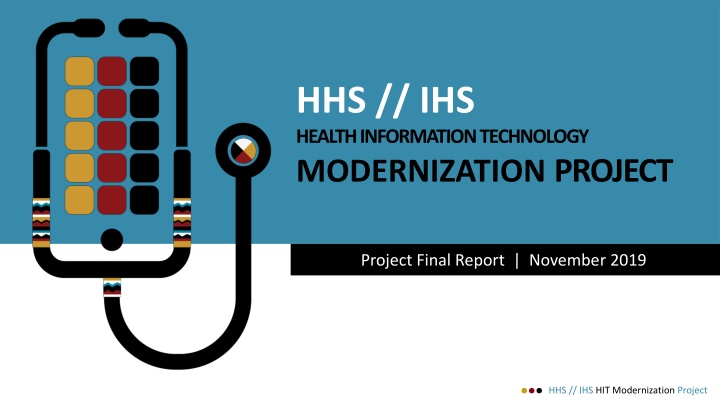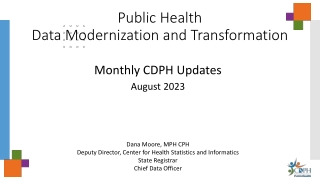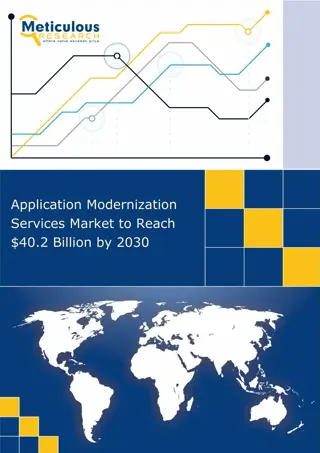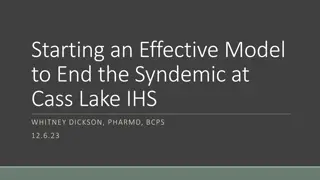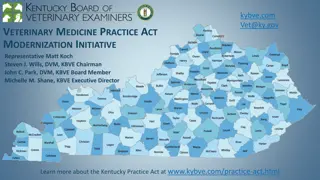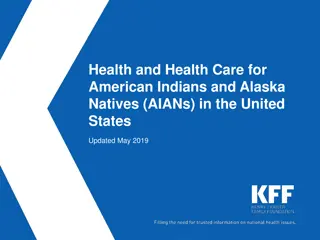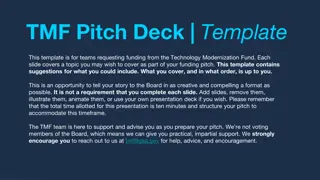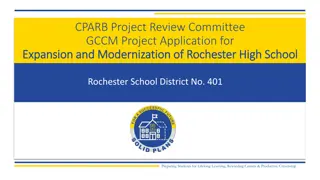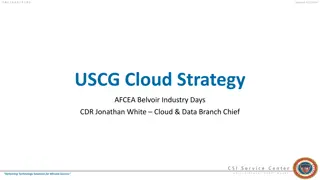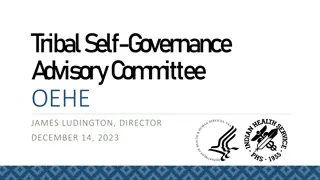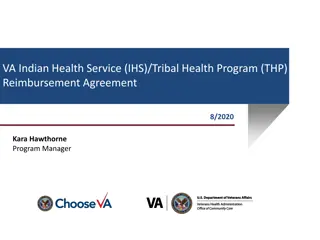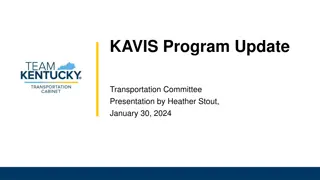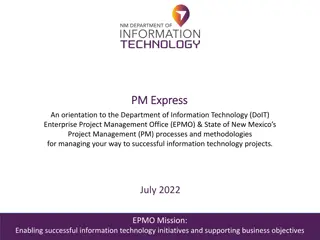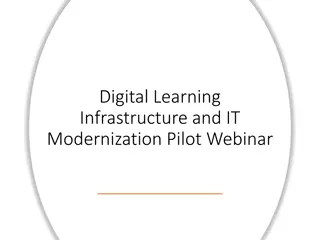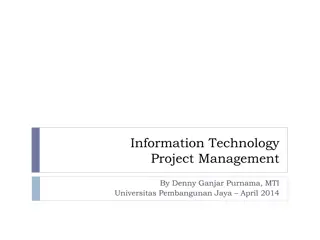IHS Health Information Technology Modernization Project Report
The project aims to modernize the EHR system and IT infrastructure of IHS to meet the evolving needs of its users, including American Indian and Alaska Native populations. By leveraging internal and external expertise, the project team conducted site visits, interviews, and evaluations to understand user needs, system capabilities, and identify best practices. The breadth of data collected through various engagements provides a comprehensive view for recommendations and a roadmap for implementation.
Download Presentation

Please find below an Image/Link to download the presentation.
The content on the website is provided AS IS for your information and personal use only. It may not be sold, licensed, or shared on other websites without obtaining consent from the author.If you encounter any issues during the download, it is possible that the publisher has removed the file from their server.
You are allowed to download the files provided on this website for personal or commercial use, subject to the condition that they are used lawfully. All files are the property of their respective owners.
The content on the website is provided AS IS for your information and personal use only. It may not be sold, licensed, or shared on other websites without obtaining consent from the author.
E N D
Presentation Transcript
HHS // IHS HEALTH INFORMATION TECHNOLOGY MODERNIZATION PROJECT Project Final Report | November 2019 HHS // IHS HIT Modernization Project
Project Purpose and Objectives IHS must create and execute a strategy to modernize its EHR system and the IT systems necessary to support it * Context Project Objectives IHS serves 2.6 million American Indian and Alaska Native people Underfunding of HIT within IHS has hindered the organization s ability to keep pace with user requirements and market solutions The VA s decision to migrate away from VistA is a catalyst for IHS to investigate EHR alternatives IHS must act swiftly to modernize its aging HIT system Leverage internal and external expertise to: Evaluate the current state of HIT across the I/T/U Identify and evaluate alternative EHR solutions for HIT modernization Produce recommendations regarding people, process and technology Define a roadmap to implement these recommendations *As stated in the Background Statement of the IHS HIT Modernization Research Project RFQ from August 2018 HHS // IHS HIT Modernization Project 2
Project Approach Using a Human Centered Design methodology, the project team developed and implemented the following three-pronged approach to better understand the current state of the IHS HIT systems and the unique needs of the users that it serves. Understand User Needs Understand System Capabilities Determine Options & Best Practices Interviews Legacy System Evaluation Literature Research I/T/U Site Visits Technical Advisory Commission (TAC) Data Calls Analysis of Alternatives Community of Practice (CoP) Plan Capability Maturity Model & Toolkit Roadmap HHS // IHS HIT Modernization Project 3
Breadth of Data Collected 25 Site visits to I/T/U facilities to engage with 450 site personnel GREAT PLAINS AREA Pine Ridge Service Unit Rapid City Service Unit BILLINGS AREA Missoula Urban Indian Health Center Northern Cheyenne Service Unit BEMIDJI AREA Forest County Potawatomi Grand Traverse Band of Ottawa & Chippewa Indians PORTLAND AREA Native American Rehabilitation Association of the Northwest 13 Virtual focus sessions with members of national workgroups CALIFORNIA AREA Round Valley Indian Health Center NASHVILLE AREA Cherokee Indian Hospital Association Kanvwotiyi Regional Treatment Center Unity Healing Center NAVAJO AREA Crownpoint Service Unit 5 ALASKA AREA Alaska Native Medical Center Chief Andrew Isaac Health Center Dena ina Wellness Center Maniilaq Health Center Sally Harvey Memorial Center Conferences, national and Tribal PHOENIX AREA Phoenix Indian Medical Center Whiteriver Service Unit OKLAHOMA CITY AREA Muscogee Creek Nation White Eagle - Ponca Nation 1,877 Responses from 240 I/T/U facilities through a Data Call and emails from site personnel TUCSON AREA Pascua Yaqui Yoeme Health Center ALBUQUERQUE AREA Albuquerque Indian Health Center Jicarilla Service Unit Zuni Comprehensive Health Center HHS // IHS HIT Modernization Project 4
Current State User Perspective Five high-level themes evolved from the insights collected from users at site visits, collected via listening sessions and interviews. In this modern world there is absolutely no reason why an out of area tribal person can t receive care from our facility. The record needs to revolve around the patient. Minimal Interoperability Our Clinical Application Coordinator (CAC) is great, but she s just one person. We need at least three of her! Inadequate Technology & Connectivity The system is so slow, or providers/nurses get 'kicked' out of the system in the middle of a note. Incomplete System Design & Disjointed User Experience Limited Workforce Inconsistent Training & Support [RPMS] has a high learning curve and takes several years to get to the point of identifying all that it can and cannot do. The written resources are not comprehensive and requires reaching out to other CACs or consultants. Our health system currently includes Medical, Pediatrics, Visiting Nurses, Hep C Treatment team, Mental Health, Chemical Dependency, Suboxone treatment, and Dental. RPMS cannot meet the demands of all of these separate services. Note: the diagram is scaled to reflect volume of comments for each theme HHS // IHS HIT Modernization Project 5
Current State User Perspective A Data Call was conducted and received responses from 1,381* HIT end users. Results showed that: 42% 60% Data Call Takeaways Capitalize on the desire for change and readiness of end users Address technological infrastructure concerns as part of the modernization effort Focus modernization on improving end user experience in 3 areas: 1. Interoperability 2. Reporting 3. Usability and data entry of users are either somewhat or very dissatisfied with how well RPMS helps them do their jobs 60% of users think RPMS needs significant improvements 93% of RPMS sites feel they are far from having the necessary hardware to complete their work of all users agree that now is the time for IHS to deploy a new HIT system HHS // IHS HIT Modernization Project 6 *Of 1,381 responses, 1,037 respondents answered all questions within the Data Call
IHS HIT Modernization Options The Analysis of Alternatives (AoA) identified and assessed four high-level options for IHS HIT modernization. Stabilizing RPMS (Option 1) is a foundational requirement but falls short of a modernized HIT solution. However, all these options, including Stabilization, require additional funding. 2 1 4 3 Renew RPMS Stabilize RPMS Full Replacement Selective Replacement Apply state-of-the-art methods to wrap & renew legacy apps with APIs/service tier Allow creation of new functions and user interfaces using modern technologies and languages Migrate to consolidated databases and cloud hosting Maintain current technical architecture and deployment approach Enhance applications as needed and as resources allow, including new graphical user interfaces Improve training and support resources to optimize utilization Identify and implement preferred pre-integrated best of suite offerings Identify preferred best of breed COTS solutions for specific domains (e.g. Lab, Billing, etc.) Selectively integrate these using standards-based service tier technologies Retain and enhance preferred RPMS apps/functions using wrap and renew approach Determine approach to retention/transfer of legacy data to new system Some features of RPMS unique to IHS may need to be retained or redeveloped HHS // IHS HIT Modernization Project 7
High-level Operation Plan Modernization Planning Phase Two 2021 Modernization Planning Phase One 2020 Modernization Implementation 2022+ FY 2020 FY 2021 FY 2022+ RPMS Stabilization & Early Wins 2020-2022 Address immediate patient and user needs and standardize databases Address Data Governance & Interoperability 2020-2022 Establish data sovereignty and improve interoperability Infrastructure Assessment & Build-out 2020-2022+ Assess current state and address gaps by engaging federal and industry partners HHS // IHS HIT Modernization Project 8
Immediate Next Steps Immediate next steps are presented in the context of the Roadmap domains. Restructure HIT governance processes within the agency Reorganize IHS s Office of Information Technology (OIT) and fill critical vacancies Establish and charter the HIT Modernization Advisory Committee (HITMAC) Execute an acquisition for expert Program Management Office support Modernization Planning and Execution Take steps to standardize and normalize RPMS databases across the country Complete 2015 Edition certification, resolving usability issues of affected RPMS components to the extent possible RPMS Stabilization and Early Wins Improve Internal and External Interoperability, including connections to Health Information Exchanges serving appropriate states and federal agencies Data Exchange Address identified critical infrastructure gaps, engaging Federal and industry partners Infrastructure HHS // IHS HIT Modernization Project HHS // IHS HIT Modernization Project 9
Contact Information Mitchell Thornbrugh, MBA Chief Information Officer| Office of Information Technology Indian Health Service e: Mitch.Thornbrugh@ihs.gov | w: 301.443.2019 | m: 240.620.3117 HHS // IHS HIT Modernization Project HHS // IHS HIT Modernization Project 10
